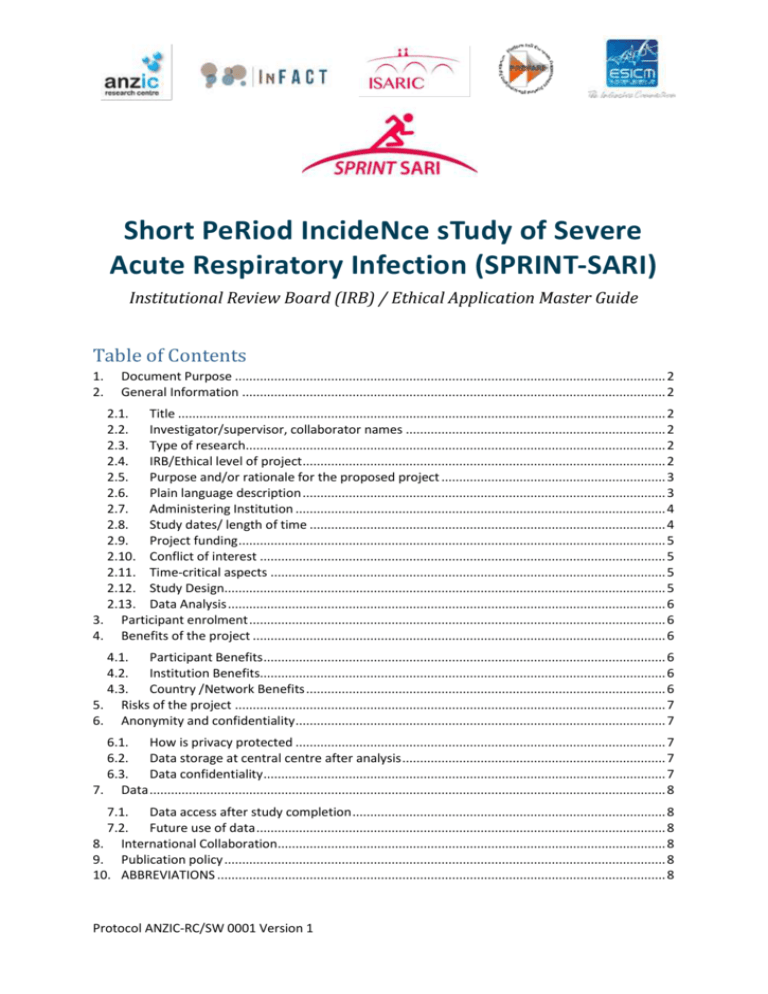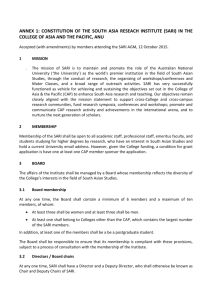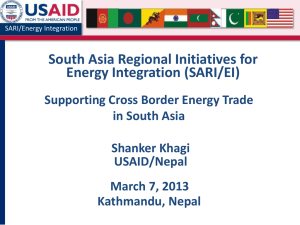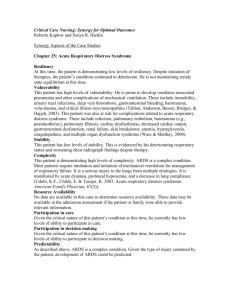(IRB) / Ethical Application Master Guide
advertisement

Short PeRiod IncideNce sTudy of Severe Acute Respiratory Infection (SPRINT-SARI) Institutional Review Board (IRB) / Ethical Application Master Guide Table of Contents 1. 2. Document Purpose ......................................................................................................................... 2 General Information ....................................................................................................................... 2 2.1. Title ......................................................................................................................................... 2 2.2. Investigator/supervisor, collaborator names ......................................................................... 2 2.3. Type of research...................................................................................................................... 2 2.4. IRB/Ethical level of project ...................................................................................................... 2 2.5. Purpose and/or rationale for the proposed project ............................................................... 3 2.6. Plain language description ...................................................................................................... 3 2.7. Administering Institution ........................................................................................................ 4 2.8. Study dates/ length of time .................................................................................................... 4 2.9. Project funding ........................................................................................................................ 5 2.10. Conflict of interest .................................................................................................................. 5 2.11. Time-critical aspects ............................................................................................................... 5 2.12. Study Design............................................................................................................................ 5 2.13. Data Analysis ........................................................................................................................... 6 3. Participant enrolment ..................................................................................................................... 6 4. Benefits of the project .................................................................................................................... 6 4.1. Participant Benefits ................................................................................................................. 6 4.2. Institution Benefits.................................................................................................................. 6 4.3. Country /Network Benefits ..................................................................................................... 6 5. Risks of the project ......................................................................................................................... 7 6. Anonymity and confidentiality ........................................................................................................ 7 6.1. How is privacy protected ........................................................................................................ 7 6.2. Data storage at central centre after analysis .......................................................................... 7 6.3. Data confidentiality ................................................................................................................. 7 7. Data ................................................................................................................................................. 8 7.1. Data access after study completion ........................................................................................ 8 7.2. Future use of data ................................................................................................................... 8 8. International Collaboration............................................................................................................. 8 9. Publication policy ............................................................................................................................ 8 10. ABBREVIATIONS .............................................................................................................................. 8 Protocol ANZIC-RC/SW 0001 Version 1 1. Document Purpose This document has been created to help reduce the amount of time sites spend on compiling an Ethics/IRB application for local IRB/Ethics approval. It is intended as a guide only, all local IRB/Ethics rules and requirements must be taken into account when writing your application. If you have any questions or need more information please contact your Network Lead or the central SPRINT-SARI project manager (email mnhs-sprint.sari@monash.edu). 2. General Information 2.1. Title Short PeRiod IncideNce sTudy of Severe Acute Respiratory Infection (SPRINT-SARI) 2.2. Investigator/supervisor, collaborator names Investigators involved in this project at your site should be named on your IRB/Ethical application. The site lead investigator assumes primary responsibility for the execution of the research at all locations this IRB/Ethical application is covering. 2.3. Type of research This is an observational study, using data collected routinely as a part of clinical care. This research will add valuable knowledge and data to the study and management of patients with severe acute respiratory infections. 2.4. IRB/Ethical level of project Waiver of Consent / low / negligible or minimal risk will be sought. Due to the importance of complete case ascertainment, that only de-identified data are submitted, and the potential benefits of the research to the wider community we are seeking to streamline data collection and ask that consent be waived. Waiver of consent is requested because this study is a population-based, epidemiology study. This research involves no intervention and all clinical information will have been collected as part of routine clinical care by health care workers who normally have access to health care records. We believe this research carries only a low risk to participants. The major potential risk is breach of privacy and this is minimised by mandatory submission of de-identified data. It is unlikely to be feasible for sites to participate if consent is required. If consent is required by your IRB/ Ethics board please contact your Network/Country lead or the central SPRINT-SARI project manager to discuss how to progress. This study involves the collection of protected health information (PHI) only by the participating site who have legitimate access to this data. The collection and retention of PHI by sites is necessary to ensure data integrity. Identifiers collected are name, date of birth, and medical record number. The data will be stored in a restricted access folder and will only be accessible to the research team at the site. NO PHI data will be disclosed to another institution or submitted centrally for analysis. PHI data will be de-identified before entering data into the central study database. The information collected does not include information that may be damaging to the individual should it be wrongfully disclosed. 2 Protocol ANZIC-RC/SW 0001 Version 1 2.5. Purpose and/or rationale for the proposed project The primary aim of this study is to establish research response capability for future epidemics / pandemics through a global Severe Acute Respiratory Infection (SARI) observational study. The secondary aim of this study is to describe the clinical epidemiology and microbiology profiles of patients with SARI. Primary Outcome: To test the feasibility of conducting a global observational study of SARI. Secondary Outcomes: Incidence of SARI Disease severity and risk factors for severe disease due to SARI Case Fatality Proportion of SARI Duration of Intensive Care Unit (ICU)/hospital stay due to SARI Microbiology of SARI, including variability in testing Treatments received during hospitalization for SARI Evaluate impact on incidence of alternative case-definitions of SARI Evaluate the operational characteristics of this study, including entry criteria, Case Report Form (CRF), and data completion guidelines to provide information by which iterative improvement in study design can be achieved. Explore the feasibility of extrapolation of results obtained at participating sites to population levels 2.6. Plain language description SARI continues to be of major relevance to public health worldwide. In the last 10 years there have been multiple SARI outbreaks around the world. The 2009 H1N1 pandemic was estimated to result in more than 200,000 respiratory deaths globally (1-3). The World Health Organization (WHO) defines SARI as an acute respiratory infection of recent onset (within 10 days) requiring hospitalisation, manifested by fever (≥38oC) or a history of fever and cough (4-7). The most common causes of SARI is influenza which is responsible for periodic pandemics. Between pandemics, SARI is still one of the leading causes of death worldwide and places a major financial burden on health systems, given the substantial hospitalization requirements for affected patients (2). There is a lack of information about the epidemiology and management of SARI patients globally, and a stated need from international bodies to establish the research infrastructure to gather this information rapidly during a time of acute need, or in an emergency such as the emergence of a new cause of SARI with epidemic potential. Recent outbreaks of pandemic influenza viruses, Severe Acute Respiratory Syndrome Coronavirus (SARS-CoV), and Middle East Respiratory Syndrome Coronavirus (MERS-CoV) have revealed that there is a significant time lag between the start of a disease outbreak and the availability of the data needed to inform clinical management and public health interventions (6-8). By creating pre-existing tools, identifying and overcoming barriers to such projects and establishing networks for global observational data collection we hope, through SPRINT-SARI, to be better prepared for the next outbreak, informing clinicians and decision-makers around the world. 3 Protocol ANZIC-RC/SW 0001 Version 1 SPRINT-SARI is an international collaborative project aimed at characterizing SARI patients on a global level to better inform management strategies and ultimately to improve the ability of health care systems to rapidly respond to emerging infectious causes of SARI. Reference List: 1. Bolotin S, Pebody R, White PJ, McMenamin J, Perera L, Nguyen-Van-Tam JS, et al. A new sentinel surveillance system for severe influenza in England shows a shift in age distribution of hospitalised cases in the post-pandemic period. PloS one. 2012;7(1):e30279. 2. Dawood FS, Iuliano AD, Reed C, Meltzer MI, Shay DK, Cheng P-Y, et al. Estimated global mortality associated with the first 12 months of 2009 pandemic influenza A H1N1 virus circulation: a modelling study. The Lancet infectious diseases. 2012;12(9):687-95. 3. Simonsen L, Spreeuwenberg P, Lustig R, Taylor RJ, Fleming DM, Kroneman M, et al. Global mortality estimates for the 2009 Influenza Pandemic from the GLaMOR project: a modeling study. PLoS medicine. 2013;10(11):e1001558. 4. Huang Q, Baker M, McArthur C, Roberts S, Williamson D, LeComte L, et al. Implementing hospital-based surveillance for severe acute respiratory infections caused by influenza and other respiratory pathogens in New Zealand. . Western Pacific Surveillance and Response Journal. 2014;5(1). 5. Investigators AI, Webb SA, Pettila V, Seppelt I, Bellomo R, Bailey M, et al. Critical care services and 2009 H1N1 influenza in Australia and New Zealand. The New England journal of medicine. 2009;361(20):1925-34. 6. Peiris JS. Severe Acute Respiratory Syndrome (SARS). Journal of clinical virology : the official publication of the Pan American Society for Clinical Virology. 2003;28(3):245-7. 7. Guery B, Poissy J, el Mansouf L, Sejourne C, Ettahar N, Lemaire X, et al. Clinical features and viral diagnosis of two cases of infection with Middle East Respiratory Syndrome coronavirus: a report of nosocomial transmission. Lancet. 2013;381(9885):2265-72. 2.7. Administering Institution The global management of this project is led by the Australian and New Zealand Intensive Care Research Centre (ANZIC RC), Monash University, Melbourne, Australia in collaboration with the International Severe Acute Respiratory and Emerging Infection Consortium (ISARIC) Coordination Centre based at the University of Oxford, Oxford, England. This study will also be coordinated regionally and /or at a Network. 2.8. Study dates/ length of time We are seeking approval to conduct this research for the maximum number of years the IRB or Ethical board is able to approve, with the intention that IRB/ethical board renewals are maintained on an ongoing basis. We request the ability to activate this study as per the current study protocol at any time within the approved period in the event of an epidemic or pandemic without applying for separate approval. In the event of an outbreak of SARI we intend to collect data using the study documents for the length of time the outbreak is considered active. The decision on the outbreak study period will be made by the local lead investigator. The SPRINT-SARI Management Committee will notify local lead investigators in the event of a SARI global pandemic; however lead investigators retain the right to decide if their site will participate in a pandemic study, including the length of the study period. 4 Protocol ANZIC-RC/SW 0001 Version 1 In between outbreak periods we will undertake “at most” yearly infrastructure study data collection periods, to ensure staff are comfortable with the study documents and processes. This study period will be for 5 to 7 consecutive days, commencing in 2016 during a 6-8 week window: Northern Hemisphere: 8 week window, 4th January to 6th March 2016 Tropical Regions: at any time during or between the Southern and Northern Hemisphere time periods Southern Hemisphere: 8 week window to be confirmed, commencing in July/August 2016 It is intended that study periods will be in the same part of the year in each region in subsequent years. 2.9. Project funding Site will receive no funding from the coordinating centre for participating in this observational study. The study has some central funding for project management from the Australian National Health and Medical Research Council; receives some support from the Platform for European Preparedness Against (Re-)emerging Epidemics which is funded by the European Union, and from the North American Cooperative for Emergency Preparedness supported by a contract from the Association of Public Health Laboratories with funds from their cooperative agreement with the Centers for Disease Control and Prevention. 2.10. Conflict of interest No researchers or investigators have a conflict of interest in the outcome of the study’s results. 2.11. Time-critical aspects To commence this study in 2016 we must have approval from IRB/Ethical boards to commence participant screening/recruitment in the relevant 6 to 8 week study period in our location. 2.12. Study Design This will be an annual and as-needed multi-centre, retrospective and prospective, observational study of patients with SARI requiring hospitalisation due to novel and emerging infection, most commonly SARI. In the first year, approximately 100 hospitals/ICUs worldwide are expected to participate. We anticipate repeating this study on up to an annual bases and scaling up the number of participating sites each year with an eventual aim of having the study approved in the majority of acute care institutions in our location with capacity to care for SARI patients. The study will comprise a 5 to 7 day observational study enrolling all participants newly admitted to the site who meet a SARI case-definition. All clinical information and data recorded will be from routine clinical practice, available from existing medical records. Fully anonymised and de-identified data will be entered into an online eCRF database. The central database, built on the CliRes Data Management System software is hosted in the United Kingdom (UK), for information email Laura Merson (Database Coordinator) email laura.merson@ndm.ox.ac.uk. In Countries unable to upload data on a centralised database the right to retain a local database on a national server is available with aggregated completely anonymised data exported centrally for analysis. 5 Protocol ANZIC-RC/SW 0001 Version 1 2.13. Data Analysis The global analysis of SPRINT-SARI categorical variables will be described as proportions and will be compared using chi-square or Fisher’s exact test. Continuous variables will be described as mean and standard deviation if normally distributed or median and inter-quartile range if not normally distributed. Comparisons of continuous variables will be performed using one-way ANOVA or MannWhitney test as appropriate. A logistic regression model will be performed to assess independent association between prognostic factors and outcomes, taking into account the hierarchical nature of the data. Significance will be set at p<0.05. 3. Participant enrolment It is anticipated that between 0-40 participants will be enrolled at each site in each annual period. This study will require site staff review all enrolled participants site medical records/chart admitted to the unit of interest during the study period. No data will be asked of any participants other than data that is already available in the medical record. Consent at the participant or surrogate decision maker level will not be sought. 4. Benefits of the project 4.1. Participant Benefits Participants in this study will not directly benefit by participating in this study. It is hoped that by undertaking this study we will enhance the knowledge of SARI which may help to improve future management of SARI patients for the wider community. 4.2. Institution Benefits The potential benefits of the research to the general community, our local region and worldwide are substantial. This research is critical to acquiring an early understanding of an epidemic of major public health significance. When fully developed, this study will allow a globally coordinated research response to collecting information about any new regional outbreak or pandemic of SARI which will, critically, utilise a common case report form and definitions. In future years, the study plans to establish a platform for observational case reporting of additional (non-SARI) infectious syndromes that may require a rapid research response. Any extension to non-SARI conditions, with a new CRF, will be subject to a new ethics application or amendment, as required. This will improve our response time to initiate outbreak research and reduce regulatory workload for research institutes and those undertaking research. The first SPRINT-SARI study period will provide national and global estimates of the prevalence of SARI (based upon common definitions), characterize presentations, progression, treatments and outcomes, and provide the basis for planning of future syndromic and infection-specific observational and interventional research. 4.3. Country /Network Benefits The project will inform public health authorities of the annual burden of SARI in hospital wards and ICUs worldwide and on a local level, allows public health authorities to rapidly respond to escalation of either number or severity of disease. Such a system may also prove to be an early warning system of the escalation of transmission, augmentation of virulence or even used as an early assessment of 6 Protocol ANZIC-RC/SW 0001 Version 1 interventions such as vaccination or population based prevention measures. This study will inform future logistic planning during SARI epidemics and/or pandemics. 5. Risks of the project This research has the potential to be conducted on vulnerable participants (e.g. children, those dependent on care, psychological/psychiatric conditions, elderly and pregnancy); Data will be accessed/used without an individual’s informed prior consent; There are no additional risks to participants or investigators. No biological specimens will be collected for research purposes. All measures will be taken to prevent inappropriate release of any personal health information which will be harmful or embarrassing to any of the stakeholder. 6. Anonymity and confidentiality 6.1. How is privacy protected Enrolled participants will be given a unique study ID on paper/electronic case report form (CRF). A master file linking unique ID with participants’ name, medical record number and date of birth will be created on paper/server used by research staff at each site. Only designated person(s) at the site will be allowed to access the master file. All CRFs will be kept on paper/password protected encrypted computer in a locked cabinet by the research team/lead Investigator. Completed CRFs will not be shared with anyone. Electronic data files with the unique study ID will be stored on a secure password protected server that will have access granted to the site research staff and lead investigator only. Any information leaving the site (e.g. aggregate data for pooled analysis) will be anonymized and identified with a unique study ID, according to data sharing plans. Data will be completely de-identified with participants recognized by unique study identifier only. 6.2. Data storage at central centre after analysis Data will be retained indefinitely by the central coordinating centre but data will be destroyed or removed if requested at any time by participating sites/Network. Paper records will be held at site for a period of time as defined by local ethical guidelines. Only the data management institution and the participating site investigator(s) will have access to the data. If others would like to use the data for analysis or publication an agreement must be reached with the coordinating centre, the site and the SPRINT-SARI management committee. All ethical, legal and regulatory requirements in that location must be adhered with. Data will be retained to provide a time-series over subsequent years that allows comparison of SARI activity with previous years. 6.3. Data confidentiality Only de-identified data will be entered in the study database, to ensure participants cannot be identified. Data will be stored securely on the database in the University of Oxford, United Kingdom and backed up on a secure server. Only aggregate data will be reported in any publication or presentation, as such no individual participant will be able to be identified from the results. 7 Protocol ANZIC-RC/SW 0001 Version 1 7. Data 7.1. Data access after study completion At the end of study, data will only be accessible to the research team (lead investigator, project manager, study statistician) and study sponsor on appropriate request in accordance with data sharing agreements. 7.2. Future use of data The data collected during this project will only be used for the purposes described above. Any additional use of data will be subject to separate ethical/IRB approval applications. Ancillary studies must submit a formal proposal to the Management Committee and include one SPRINT-SARI Management Committee member as an investigator on the ancillary study. 8. International Collaboration SPRINT-SARI will be conducted in conjunction with the World Health Organisation (WHO), the Australian and New Zealand Intensive Care Research Centre (ANZIC RC) International Severe Acute Respiratory and Emerging Infection Consortium (ISARIC), The International Forum of Acute Care Trialists (InFACT), the Platform for European Preparedness Against (re)-emerging Epidemics (PREPARE). 20-30 hospital/ICU based formal and informal Networks are participating supporting and/or identifying approximately 100 hospitals/ICUs worldwide. 9. Publication policy Publications using data collected by the SPRINT-SARI Investigators will be published on behalf of the SPRINT-SARI Investigators with a writing committee taking responsibility for all manuscripts. All members will be given the opportunity to contribute to the work of writing and all members of the writing committee who make a contribution to the writing will be recognised with authorship. Site lead investigators who are not on the writing committee will be recognised as SPRINT SARI Investigator and noted in all manuscripts. SPRINT-SARI adheres to the ISARIC Publication Policy, Version 2, 21 July 2014 (https://isaric.tghn.org/). 10. ABBREVIATIONS Abbreviation ANZIC RC CRF Full name the Australian and New Zealand Intensive Care Research Centre Case Report Form ICU Intensive Care Unit ISARIC International Severe Acute Respiratory and Emerging Infection Consortium University of Oxford Clinical Research Unit, Viet Nam Protected Health Information OUCRU PHI Definition N/A Is a paper or electronic questionnaire specifically used in clinical research. A designated area of a hospital facility that is dedicated to the care of patients who are seriously ill. N/A N/A Is any information about health status, or provision of health care that can be linked to a specific individual 8 Protocol ANZIC-RC/SW 0001 Version 1 MERS-CoV SARI SARS-CoV SPRINT-SARI WHO Middle East Respiratory Syndrome Coronavirus Severe Acute Respiratory Infection Severe Acute Respiratory Syndrome Coronavirus Short PeRiod IncideNce sTudy of Severe Acute Respiratory Infection World Health Organization N/A N/A N/A N/A N/A 9 Protocol ANZIC-RC/SW 0001 Version 1






